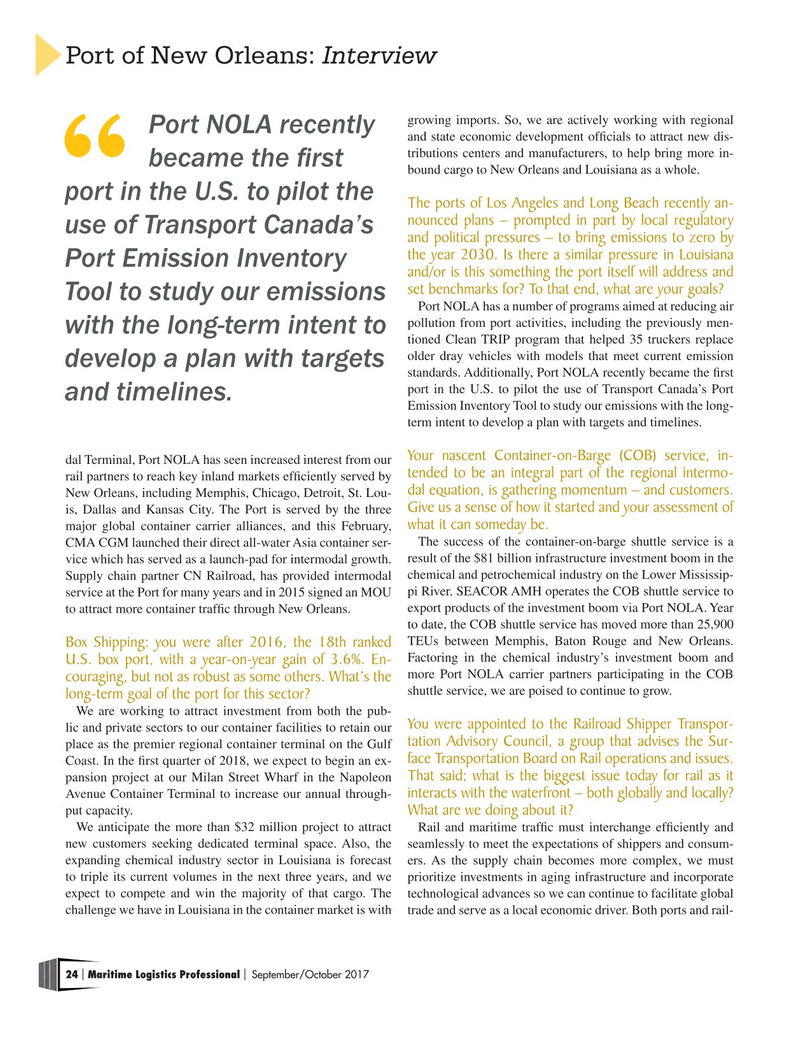
Page 24: of Maritime Logistics Professional Magazine (Sep/Oct 2017)
CONTAINER PORTS
Read this page in Pdf, Flash or Html5 edition of Sep/Oct 2017 Maritime Logistics Professional Magazine
Port of New Orleans: Interview growing imports. So, we are actively working with regional
Port NOLA recently and state economic development offcials to attract new dis- tributions centers and manufacturers, to help bring more in- became the frst bound cargo to New Orleans and Louisiana as a whole.
port in the U.S. to pilot the
The ports of Los Angeles and Long Beach recently an- nounced plans – prompted in part by local regulatory use of Transport Canada’s and political pressures – to bring emissions to zero by the year 2030. Is there a similar pressure in Louisiana
Port Emission Inventory and/or is this something the port itself will address and set benchmarks for? To that end, what are your goals?
Tool to study our emissions
Port NOLA has a number of programs aimed at reducing air pollution from port activities, including the previously men- with the long-term intent to tioned Clean TRIP program that helped 35 truckers replace older dray vehicles with models that meet current emission develop a plan with targets standards. Additionally, Port NOLA recently became the frst port in the U.S. to pilot the use of Transport Canada’s Port and timelines.
Emission Inventory Tool to study our emissions with the long- term intent to develop a plan with targets and timelines.
Your nascent Container-on-Barge (COB) service, in- dal Terminal, Port NOLA has seen increased interest from our tended to be an integral part of the regional intermo- rail partners to reach key inland markets effciently served by dal equation, is gathering momentum – and customers.
New Orleans, including Memphis, Chicago, Detroit, St. Lou-
Give us a sense of how it started and your assessment of is, Dallas and Kansas City. The Port is served by the three what it can someday be.
major global container carrier alliances, and this February,
CMA CGM launched their direct all-water Asia container ser- The success of the container-on-barge shuttle service is a vice which has served as a launch-pad for intermodal growth. result of the $81 billion infrastructure investment boom in the
Supply chain partner CN Railroad, has provided intermodal chemical and petrochemical industry on the Lower Mississip- service at the Port for many years and in 2015 signed an MOU pi River. SEACOR AMH operates the COB shuttle service to to attract more container traffc through New Orleans. export products of the investment boom via Port NOLA. Year to date, the COB shuttle service has moved more than 25,900
TEUs between Memphis, Baton Rouge and New Orleans.
Box Shipping: you were after 2016, the 18th ranked
Factoring in the chemical industry’s investment boom and
U.S. box port, with a year-on-year gain of 3.6%. En- more Port NOLA carrier partners participating in the COB couraging, but not as robust as some others. What’s the shuttle service, we are poised to continue to grow. long-term goal of the port for this sector?
We are working to attract investment from both the pub-
You were appointed to the Railroad Shipper Transpor- lic and private sectors to our container facilities to retain our tation Advisory Council, a group that advises the Sur- place as the premier regional container terminal on the Gulf face Transportation Board on Rail operations and issues.
Coast. In the frst quarter of 2018, we expect to begin an ex-
That said; what is the biggest issue today for rail as it pansion project at our Milan Street Wharf in the Napoleon interacts with the waterfront – both globally and locally?
Avenue Container Terminal to increase our annual through- put capacity.
What are we doing about it?
We anticipate the more than $32 million project to attract Rail and maritime traffc must interchange effciently and new customers seeking dedicated terminal space. Also, the seamlessly to meet the expectations of shippers and consum- expanding chemical industry sector in Louisiana is forecast ers. As the supply chain becomes more complex, we must to triple its current volumes in the next three years, and we prioritize investments in aging infrastructure and incorporate expect to compete and win the majority of that cargo. The technological advances so we can continue to facilitate global challenge we have in Louisiana in the container market is with trade and serve as a local economic driver. Both ports and rail- 24 Maritime Logistics Professional September/October 2017 | |

 23
23

 25
25
